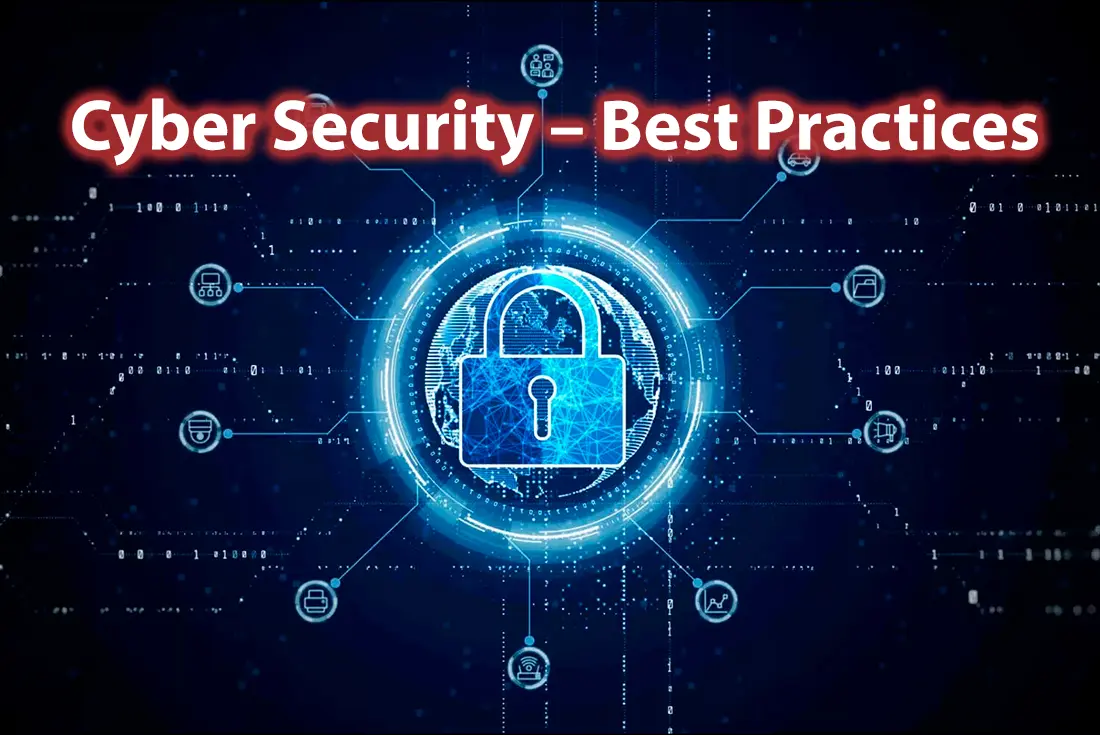
13 May Cyber Security – Best Practices
Think your business is too small to be a target for hackers? Think again. Cyber-attacks are on the rise, and businesses of all sizes are vulnerable. Data breaches, stolen customer information, or crippling downtime can devastate your hard work. Don’t leave your business exposed – proactive security is essential today.
Keep reading our cyber security planning guide and discover practical steps to safeguard your digital assets.
Understanding Cyber Security
Cyber security is about how you protect your computers, networks, and important data from hackers. It’s like installing a high-tech security system for your digital world. But what threats do businesses need to protect themselves from?
- Malware — software like viruses, ransomware, and spyware. Viruses can damage your files, ransomware can lock your computer and demand payment, and spyware tracks what you do to steal passwords and other data.
- Phishing — fake emails or websites that try to trick you into giving away passwords or downloading malware. These fake emails might impersonate your bank, a big online store, or even someone you know.
- Social engineering — tricking people into giving up sensitive information or breaking normal security procedures. A hacker might pretend to be an IT worker over the phone and ask for your password “to fix your computer”.
Since hackers are always coming up with new tricks, you need to stay up-to-date and aware to protect yourself. It helps to think like a hacker – if you were trying to break into your own business, where are the weak spots?
Importance of Cyber Security for Businesses
When hackers steal customer data, credit card information, or sensitive company secrets, it’s catastrophic. You can lose customer trust, face legal penalties, and sink a lot of time and money into the cleanup process.
Here’s just one example. In June 2021, LinkedIn, a professional networking platform with over 700 million users worldwide, experienced a significant data breach. Hackers scraped a massive amount of publicly available user profile data — more than 90% of the company’s user base. While this didn’t include sensitive information like passwords or direct messages, it did expose names, email addresses, phone numbers, job titles, and more. This stolen data was then put up for sale on the dark web, making it accessible to other cybercriminals.
The consequences of this attack were widespread. Individuals whose data was exposed became targets for phishing campaigns, scams, and identity theft attempts. The breach also damaged LinkedIn’s reputation and potentially impacted users’ trust in the platform.
So, even companies with seemingly robust security measures can fall victim to cyberattacks. This case highlights the importance of protecting all user data, even information that might seem ‘public,’ as it can still be exploited by bad actors.
Every business is a target, and partnering with a cyber security services company is the right way to protect yourself. Downtown Computer Services offers comprehensive solutions to fortify your defenses. Contact us today for a consultation: (954) 524 9002.
Key Cyber Security Best Practices
While no system is foolproof, there are many effective strategies to reduce your risks. Here’s a cyber security planning guide:
Employee Training and Awareness
Your employees are your first line of defense, so regular training is crucial. Focus on how to recognize phishing attacks by looking for suspicious emails with urgent requests, misspellings, or strange URLs. Teach them the importance of strong passwords, emphasizing that they should use unique passwords for every account, avoid simple phrases, and change them regularly. Explain social engineering scams, instructing employees to be wary of unusual requests for information or suspicious phone calls that claim to be from IT support or banks. Finally, make sure employees know how and when to report potential cyber threats to your IT department or digital security team.
Password Management
Enforce strong password policies. Require a mix of uppercase, lowercase, symbols, and numbers with a minimum length (12+ characters is ideal). Disallow common words or easily decipherable personal information, and make employees change their passwords regularly. Consider using a password manager, which can securely store and generate strong, unique passwords for different websites and services.
Access Control
Limit access to sensitive data and systems based on employees’ job roles. Grant only the minimum access necessary for employees to do their job effectively. Implement multi-factor authentication, which supplements passwords with an additional verification step, like a code sent to a phone or a biometric scan, adding an extra layer of security.
Software Updates
Hackers exploit known vulnerabilities, so it’s essential to keep operating systems, web browsers, and all software up to date with the latest security patches. Enable automatic updates when possible so you don’t have to rely on manually checking. Also, stop using any old software that is no longer supported, as it’s an easy target for attackers.
Encryption
Encrypt sensitive data both when it’s stored and when it’s being transmitted. For data at rest, make sure it’s encrypted on devices and in the cloud. Use strong encryption protocols for website traffic and encrypted email solutions to protect data in transit.
Securing Digital Assets and Infrastructure
Digital security isn’t just about individual devices; you need to protect the entirety of your network, servers, and cloud solutions. Here’s a more detailed look at how to do that:
Firewalls
A firewall is your network’s frontline defense. There are several types of firewalls:
- Network firewalls monitor and filter traffic between your internal network and the internet, blocking unauthorized access based on predefined rules.
- Web application firewalls (WAF) are specifically designed to protect web applications from common attacks like SQL injection and cross-site scripting. These are critical if you run public-facing websites or web apps your employees use.
- Next-generation firewalls (NGFW) combine traditional firewall features with advanced capabilities like intrusion prevention, deep packet inspection, and application awareness for more sophisticated protection.
Don’t just install a firewall and forget about it. Define clear firewall rulesets that specify what traffic is allowed and what should be blocked based on your business needs. Monitor firewall logs for any suspicious activity.
Antivirus and Anti-Malware Software
Robust antivirus and anti-malware software are essential for every device connected to your network. Look for reputable business-focused antivirus and anti-malware tools. Consider features like real-time protection, heuristic detection, and endpoint protection.
Install antivirus/anti-malware on EVERY computer, laptop, server, and even mobile devices connected to your network. A single unprotected device can be an entry point for a threat. Keep your antivirus up-to-date and schedule regular full system scans.
Intrusion Detection and Prevention Systems (IDS/IPS)
IDS and IPS act like watchdogs for your network, actively monitoring everything that flows through it. An IDS passively monitors your network traffic, looking for patterns that might signal an attack. It alerts you to potential threats but doesn’t take preventative action itself. IPS takes IDS a step further. It has the power to automatically respond to detected threats. It can block malicious traffic, reconfigure firewalls, or even isolate infected devices to contain a breach. Some advanced IDS/IPS use AI or machine learning for more sophisticated and adaptive threat detection.
However, even with an IDS/IPS, no defense is perfect. They need careful tuning to reduce false positives and can still be overwhelmed in some situations. They are a powerful tool, but best used as part of a layered security approach. Therefore, look for solutions that integrate with your other security tools.
Network Segmentation
Imagine your network is like a large house. Network segmentation is like adding rooms and locked doors within that house. This helps contain problems if they arise.
Without segmentation, if a hacker breaches one part of your network, they have free rein to move around and wreak havoc. Segmentation creates barriers, restricting the spread of malware and giving you time to react. It also keeps your most critical assets on their own network segment with stricter security controls. If a general-use computer gets compromised, the attacker won’t have immediate access to those crown jewels.
How is network segmentation done?
- Virtual Local Area Networks (VLANs) allow you to logically divide a physical network into smaller, isolated segments.
- Software-defined networking (SDN) provides more flexible and granular control over network segmentation using software-based controls.
- Micro-segmentation goes one step further, allowing you to create fine-grained security zones around individual workloads or even applications.
Network segmentation is a complex thing. Work with a cyber security services company to ensure it’s done effectively.
Cloud Security
Using cloud services offers many benefits but also introduces unique security considerations. Select a reputable cloud service provider. Find out:
- What security certifications do they hold (e.g., SOC 2, ISO 27001)?
- How do they handle data encryption, both at rest and in transit?
- What are their incident response procedures and breach disclosure policies?
However, keep in mind that the provider secures their infrastructure; YOU are responsible for how you use the services. Enforce strong identity and access management (IAM) practices within your cloud environments. Implement strict access controls to dictate who can access what data. Always encrypt sensitive information both while stored and in transit. Pay careful attention to security configurations within your cloud environment, regularly monitoring logs for unusual activity. When using third-party apps or services connected to the cloud, evaluate their security practices to avoid introducing new vulnerabilities.
Building a Culture of Cyber Security
Technology alone can’t fully protect your business. Creating a security-focused mindset across your entire organization is essential for long-term success.
We mentioned training before, but it’s worth emphasizing. Make regular digital security education mandatory for everyone. Gamify it to create a positive association with staying secure.
Develop clear policies that outline expectations around issues like how to handle sensitive data, password requirements, and what to do if an employee suspects a cyber threat.
Create a step-by-step plan for what to do in case of a breach and test it regularly.
Leaders should set an example by following best practices and driving a shared responsibility culture.
Conclusion
The reality is cyber-attacks aren’t just a threat to big corporations. Hackers target businesses of all sizes, and the consequences can be devastating. Taking digital security seriously isn’t a luxury; it’s the cost of doing business in the 21st century.
You’ll significantly reduce your risk profile by implementing the strategies we’ve discussed. More importantly, you demonstrate to customers, partners, and employees that you’re committed to protecting their data and your business’s future.
Don’t risk your business! Contact Downtown Computer Services now at (954) 524 9002 to learn how we can protect you from cyber threats.
Check out other relevant news
- How Easy-to-Use Hacking Tools Are Fueling Cybercrime
- Cryptocurrency Security for Small Businesses: Protecting Your Wallet
- The Infostealer Epidemic: Protecting Your Business from the Latest Wave of Cyberattacks
- The Identity Crisis: How Compromised Credentials Can Cripple Your Business
- Beyond the Brick and Mortar: Building Your Online Storefront with Digital Marketing
